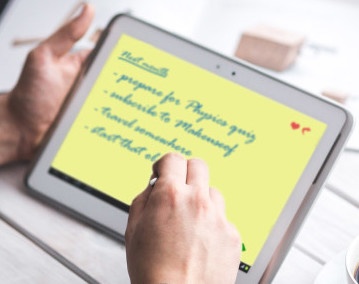Digital Note Taking

Beth Holland’s recent blog piece Digital Note Taking Strategies that Deepen Student Thinking, written for Mind/Shift, includes some helpful suggestions for using technology to support student note taking. I wrote a post in October 2016 that referred to earlier pieces written by Holland on a similar topic, Note Taking Technology. Her current suggestions are so good that I want to revisit this topic again.
Holland begins by referring to two studies that concluded note taking by hand is more effective than digital note taking. I wrote about one of these studies, The Pen is Mightier Than the Keyboard, by Mueller and Oppenheimer, in my October 2015 post titled The Advantages of Taking Notes by Hand. Their study found that college students who were fast at typing were able to take very detailed notes on their laptops — almost transcribing what the lecturer was saying. On the other hand, when students wrote their notes by hand, they did not write as much, forcing them to curate and summarize the information in their own words. Despite having less detailed notes, the students who handwrote retained more. This finding makes perfect sense! When we train teachers to teach note taking and summarizing skills, we emphasize that the goal of these tasks is to push students to think about what they are hearing or reading and then synthesize and paraphrase it in their own words. It is this meta-cognitive step that supports comprehension and long-term retention, so it is no surprise that students who simply transcribe information into typed notes don’t learn or retain as much
I have referenced this research often as a way to help teachers understand the ultimate goal of note taking. However, as Holland points out in her newest post, the results of this study should not lead educators to conclude that technology and devices should be avoided when taking notes. Instead, Holland presents several ways that technology can be used to support deeper learning during note taking. Here are a few of her suggestions:
- Tools like Notability or OneNote enable students to organize multiple note documents. A key advantage of these kinds of tools is that students can search their typed content.
- Digital notes have an advantage over paper notes because students can capture information in multiple forms – i.e., photos, audio, and video.
- Students can use concept mapping tools to take notes more easily than handwriting graphic organizers. Paper has limitations (size of the page, lack of editing ability) compared to electronic documents that expand as a graphic organizer grows. And software programs make it easier to add, delete, and move items around on a page.
All of Holland’s suggestions recognize that students have to THINK while they take notes.
Educators familiar with topic webs, two-column notes, and summarizing strategies from Keys to Literacy teaching routines understand the power of metacognition and the impact of the strategies on student comprehension. This is true whether students are constructing notes on paper or electronically.

 Joan Sedita is the founder of Keys to Literacy and author of the Keys to Literacy professional development programs. She is an experienced educator, nationally recognized speaker and teacher trainer. She has worked for over 35 years in the literacy education field and has presented to thousands of teachers and related professionals at schools, colleges, clinics, and professional conferences.
Joan Sedita is the founder of Keys to Literacy and author of the Keys to Literacy professional development programs. She is an experienced educator, nationally recognized speaker and teacher trainer. She has worked for over 35 years in the literacy education field and has presented to thousands of teachers and related professionals at schools, colleges, clinics, and professional conferences.
Leave a Reply